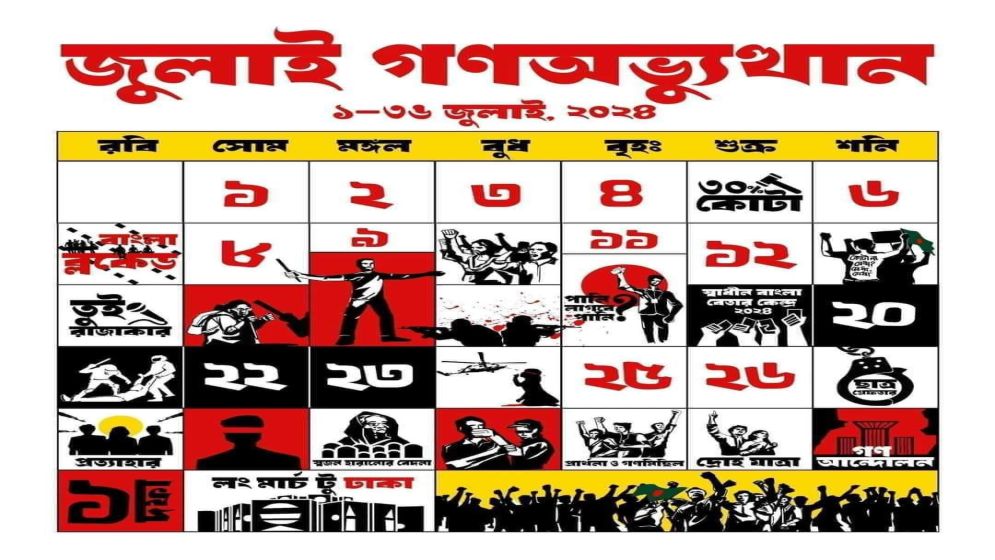
I was in the middle of two conversations in the evening of 14 July: a rather heated discussion about the state of the economy in a whatsapp thread full of wonks and quants; and a depressing group call with a few dissidents, which also included a famous journalist.
Other than the journalist, no one said anything about what was going on in the universities.
And he even mentioned it with respect to Hasina’s press conference earlier that evening. I woke up with the videos of rallies that shook the campuses overnight, followed by Chhatra League violence against the protesters.
Even at that stage, I didn’t expect what was to come. Rather, following a question from the smartest person I know, I was trying to figure out the number of jobs and jobseekers being affected.
Then came escalating violence — six killed on the 16th, including Abu Sayeed.
We drafted a statement, to be signed by the members of the global diaspora community, denouncing the killing of Abu Sayeed and others. The first draft had six deaths.
-66dab9d19cd36.jpg)
By the time it had been finalized, 73 people were confirmed to have been killed by the Hasina regime.
It was on the 17th that I first sensed a major shift in public perception. There were social media posts by people I knew to be supporters of the regime, including a well-known civil society personality.
And there was the response to the diaspora statement, which significantly surpassed our expectations.
###
The regime must have also sensed that things were somewhat off.
Public universities were shut and students forcibly evicted on the 17th afternoon — something that last happened in 1990, in the last weeks of the Ershad regime.
Hasina addressed the nation that evening. She must have thought the speech would diffuse the situation. But if anything, she inflamed the situation, because the next 48 hours saw an escalation in both protests and reprisals.
Private universities as well as madrassah and college students joined the protests on the 18th, and the country was effectively shut down on the 19th.
-66daba14eed46.jpg)
I went to sleep on the 19th with several whatsapp threads discussing ‘popular uprising’ and ‘crackdown’.
It was a very short sleep, as I woke up with several calls from all around the world — curfew was imposed, the army was being deployed, and the internet was cut off.
The 20th was a very stressful day. I was worried about the loved ones in Dhaka, including people who were supposed to fly out that day.
I was to travel that day for work, perhaps the least prepared mission I had ever been on. Over the next 24 hours, I kept checking the phone every few minutes. It seemed everyone was equally in the dark.
###
The following week was a blur, as days seem to blend into each other. Footages of atrocities — police and BCL on rampage, helicopters above Dhaka, fire — contrasted with propaganda — Hasina’s tears, her acolytes and ministers terming everyone terrorists and traitors.
There was despair and rage, as whatsapp threads proliferated.
-66daba409e62a.jpg)
But there were also action-oriented threads. At the micro level, my university was to host the Bangladesh High Commissioner for a seminar in August — surely this had to be stopped! And at the macro level, as best as we can tell, the remittance boycott did hit the regime hard.
On 29 July, everyone turned red — making it so very clear how widespread the public anger was.
All that said though, as I returned home, it did look like Hasina had prevailed, at least for now. That was Wednesday 31 July.
July would go on for five more days.
###
There was a public vigil for Bangladesh in my little town.
I had taken my 14 year old. I met people there who I never heard utter a single political statement in all the years I had known them. My kid dedicated his Saturday soccer match to the fellow students in Bangladesh.
-66daba8284cf7.jpg)
Back in Bangladesh, things heated up again, and a new cycle of mood swing begun for me — I would wake up feeling ominous about the atrocities the day would bring, but as the day progressed, my mood lifted with the news of defiance from Bangladesh as well as with all the activities — public and behind the scene — that I was party of, until it all would come full circle as I would crash into bed feeling drained and weary.
Sunday night was the hardest. That day had seen over a hundred dead.
A diaspora zoom call was organized on Sunday night, where the names of the identified shaheed were read out. It was hard not to feel depressed.
Of course, there was no time to feel depressed. Messages were coming from Dhaka about the legal framework around a transitional government. Meanwhile, there was an effort to use satellites to observe whether the military deployed in Dhaka would commit large scale massacres.
Somewhere between chores and errands and endless messages and calls, I started hearing that good news was imminent from Dhaka — as a fellow traveler put it: No way the army chief will be speaking if Hasina is in power.
Slightly before 2pm, I received the video of Hasina’s helicopter flying out of Ganabhaban. Shortly after 2pm, we all watched Ganabhaban being stormed.
The phone kept buzzing as we waited for confirmation. But by then I knew that the long July had ended with victory.
—-

